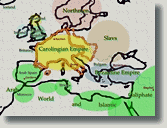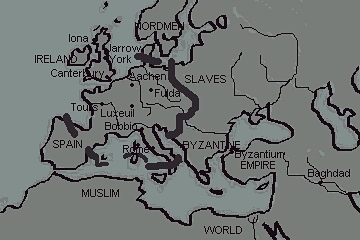

The Carolingian empire, had to deal with various countries and people, be them incorporated into it, or being at its borders, with the following notices introducing them to you. A section is dedicated too to the rest of the world (all notices by alphabetical order in each section). A section further illustrates, by the mean of pictures, the landscapes one could encounter in the Carolingien times or those one might have heard of. The embassies he received or sent, Charlemagne never met personally any other sovereign of his time, popes excepted. Albeit notoriously unreliable for a lack of censuses, estimate numbers for the European population at the Carolingian times may be like (numbers in million of inhabitants by 1000 A.D; numbers in brackets are those for 650 A.D.). For some, the Carolingian empire would account for 15 to 20 millions of inhabitants, a level never to be abandoned during the following centuries. France with Low Countries amounted to 6 (3) as Germania with Scandinavia to 4 (2). England features 2 (0.5). Italy was featuring 5 (2.5), Spanish peninsula by 7 (3.5) as Balkans (with Greece) at 5 (3) and Hungary at 1.5 (0.5). The Byzantine Empire, in its entirety, valued at 12 (13?-7). Russia amounted to 6 and Poland to 2 as Slavic tribes, by 600 A.D., amounted to 3. Jews in Europe accounted for 1.5 million persons. Let's recall that by the apogee of Rome, the three main political powers of Eurasia at that time -the Roman empire, India, China- were each worth 50 million people. The areas of the Roman empire, after the Great Invasions, had felt down to 30 million only as the German tribes which had settled into represented 1 million people only as the Gallo-Roman nobility, in Gauls, stood at 3,000. By the end of the period we are studying, by about 1000 A.D., the three main powers worldwide of the time were Chine, India and Africa. It is possible that over centuries, the fundamental realities of peoples and populations remained the determinants of History
 | click to a view of the Carolingian world |
![]()
People and Countries Incorporated Into the Carolingian Empire
People and Countries At the Borders of the Carolingian Empire
The Rest of the World
The Landscapes of the Empire, the Surrounding Lands and the World
The Bavarians
Brittany
The Other German Peoples
The Lombards
The Papal States
Germanic Peoples, The Frisians
Germanic Peoples, The Saxons
The Slavs
The case of Jews
Climate Cycles in The Carolingian Era
The Avars
The Arabs in Spain
The Byzantine Empire
The Kingdoms of England
Ireland (With a Note About Scotland)
The Islamic Caliphate
The 'King of the Africans'
The Magyars (With a Note About Bulgars)
Northmen and the Viking Raids
Visigothic Spain
Small notice about the origins of the peoples of Europe: the Indo-European theories in their most modern form
 | click to a civilizational view of the world in the Carolingian era |
Africa
Americas
Central Asia
China and The Far-East
India, Tibet, Indonesia
Oceania, Australia
Trade routes and lobbying groups:
Agricultural West Vs. Merchants Power and Trade Routes of the East
The Nestorians, Missionaries in China and A Power Under the Abassides
Small notice about how the Carolingians might have considered the origins of peoples, from the Bible
From the Empire proper to the farthest reaches of the world as known at the time, the people of the Carolingian empire could see the whole variety of the landscapes of the world, or having heard of...
. The Carolingian empire and its nearest neighbours
 |
 |
 |
 |
 |
 |
| Ireland | Countries of the Northmen | Frankish Heartland | The Alps | Countries of the Baltic Sea | Southern Slavic Tributaries |
 | |||||
 |
 |
 |
 |
 | |
| Spain | Italy | The Byzantine Empire | The Abassid Caliphate | The Ifriqiya | |
. The outer reaches of the known world
 |
 |
 |
 |
 |
 |
| Americas | Iran | Central Asia | India | China | Southeastern Asia |
 |  | ||||
| Caravans of the Sahara Desert | Africa |
(pictures for Scandinavia, the Frankish heartland, the Baltic shores, the southern Slavic countries, the Byzantine empire, the Abassid Caliphate, Ifriqiya, Greenland, China, the southeastern Asia, the Sahara desert, and Africa are published under the GNU license (a copy of which is available at WikipediA); picture Pamir based on a picture published under the Creative Commons Attribution 1.0 (a copy of which is available at http://creativecommons.org/licenses/by-sa/1.0/); picture for Iran is copyright Asana Mashoufiran; picture for India is copyright kalyan and published under the Creative Commons Attribution ShareAlike 2.0 license (a copy of which is available at http://creativecommons.org/licenses/by-sa/2.0/); other pictures are copyright the site 'Learning and Knowledge In the Carolingian Times / Erudition et savoir à l'époque carolingienne')
Website Manager: G. Guichard, site Learning and Knowledge In the Carolingian Times / Erudition et savoir à l'époque carolingienne, http://schoolsempire.6te.net. Page Editor: G. Guichard. last edited: 6/9/2019. contact us at ggwebsites@outlook.com